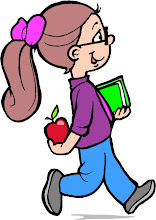We are starting with
The Child's Own English Book "The Adjective". Here are the games we played:
- I'm Thinking of Something -- describe an object in the room and see if the other person can guess what it is
- My Grandmother's Cat -- use the sentence "My grandmother's cat is a/an (insert adjective) cat." Go through the alphabet with each player inserting an adjective that starts with the letter A. Then B, C, etc.
- Similar and Opposite -- find adjectives with meanings similar or opposite to a list given.
- Blank Spaces -- The story of Cinderella was in the book with blanks in place of the adjectives. We read the story inserting adjectives.
This week we were learning about maps, concentrating on color coding. I found a worksheet I liked at Super Teacher Worksheets. It was a map of a campground, which gave me the idea of going to the KOA website and printing out a couple maps of different campgrounds -- I found a couple that had good color coding. We finished up the week with making a color coded map of our bedrooms.
Now we are learning about diagrams.
I found one of a piano and one of a shoe on-line and printed them out. The first day we talked about them.
The next day I gave K. a drawing of an elephant and a list of body parts. She numbered the body parts, and then numbered the parts on the elephant.
We also made a craft of a flower, and labeled the parts. I saw this one on a teacher's blog.
We learned about Venn diagrams, and practiced with a selection of her blocks. (Red/Round; Blue/Rectangle; Yellow/Arch) You can use string to make circles on the floor.
-
We review the rules we have learned this year about using Capitals and Punctuation. Then we spent the rest of the week writing a story, making sure we capitalized and used punctuation correctly. We used the game That's Good / That's Bad from Games for Writing.
This week we practiced using street maps. I pulled out our Thomas Guide and we found where we live. On other days we found where friends or family live, where our favorite park is, etc. Then we would figure out different ways of getting from our house to that location.





